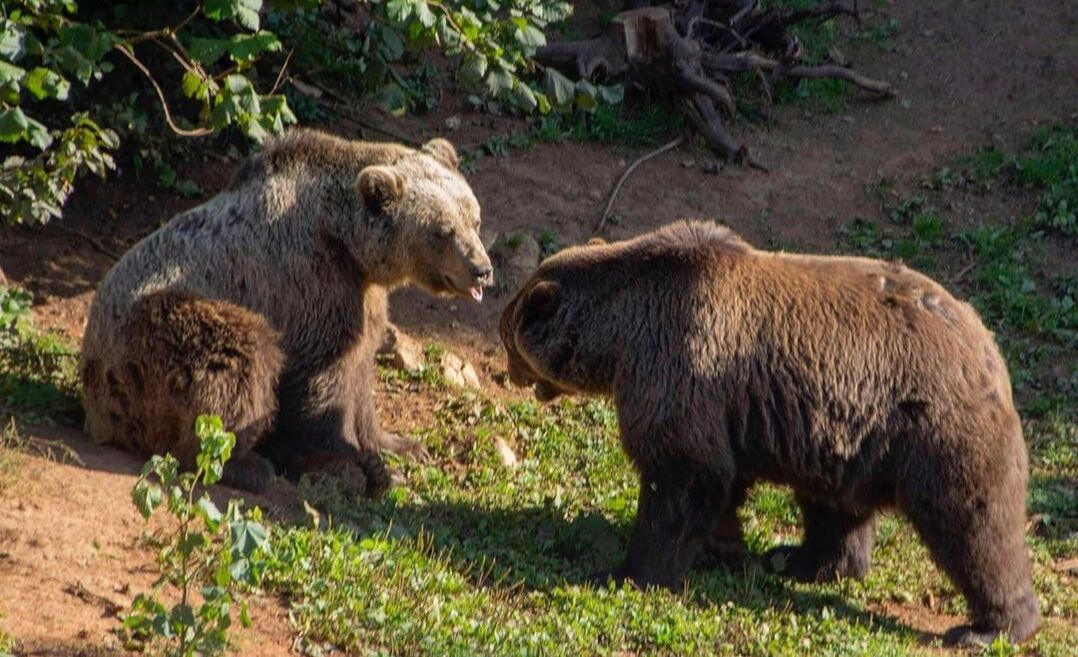Croatia is home to many wild animals (including snakes, bears, sharks and scorpions to name a few). Here I have put together a helpful guide showing which animals are dangerous, where they can be found in Croatia, what you should look out for, and what to do if you get bitten.
A quick overview:
- Vipers are the only poisonous species of snake in Croatia, and can be identified by the zig zag pattern on their backs.
- There is a large population of brown bears in continental Croatia - if you run into one, just play dead.
- There are multiple species of sharks in the Adriatic, but only two are actually dangerous - and attacks are extremely rare.
- Watch out for black spiders with red dots on their backs (black widows), mainly found along the coastline - their bites are painless, but deadly.
- Look out for sea urchins in the water, close to the shore - they’ll prick your feet, making it painful to walk for the rest of your vacation!
- Scorpions do exist in Croatia, but if they sting you, their poison isn’t strong enough to be life threatening.
1. Snakes
There are a few species of poisonous snakes in Croatia, which all belong to the “Viper” family. They can be recognized by the zigzag pattern on their backs, and if you get close enough to look into their eyes, you’ll notice their pupils form a vertical slit.
Here is a list of a few specific vipers and where they can be found in Croatia.
Horned Viper
Common European viper
Here is a list of a few specific vipers and where they can be found in Croatia.
Horned Viper
- Found in almost all parts of Croatia
- Much less common in the northeastern part of the country
- More common along the coast and have been seen on the islands, too
- You probably won’t find them on Rab Island, Dugi Otok or Mljet
Common European viper
- Found in river lowlands of the Sava, Drava, Mura and Danube Rivers
- Found in mountainous regions of Gorski Kotor
- Found in meadows and long other freshwater shores
Meadow viper
What to do if you see a snake in your path?
What to do if you’re bitten by a snake?
In the last 25 years, only four people have been killed by bites and poison of viper in the area of Split-Dalmatia County.
- They are common in the Dinara mountain range
- They can be found in Southern Velebit
- They generally like to live in grassy parts of the mountains at higher altitudes (1000m +)
What to do if you see a snake in your path?
- If you see a snake, stay calm and don’t move any closer
- Slowly walk away from the snake and give it space
- Don’t scare the snake or try to move it
- Wait at a safe distance for the snake to move (if it’s in the way of your path), otherwise, slowly walk far around it
What to do if you’re bitten by a snake?
- Stay calm and try to keep the bitten limb as still as possible to prevent the poison from spreading further
- Seek medical assistance immediately
In the last 25 years, only four people have been killed by bites and poison of viper in the area of Split-Dalmatia County.
2. Black Widow Spiders
The Mediterranean Black Widow
The most poisonous spider in Europe is the black widow, which can be recognized by its black body and red spots on their backs. In Croatia, they can be found in the Istrian region, Primorje, as well as in Dalmatia.
Black widows are even more poisonous than many venomous snakes (although the males aren’t dangerous). It’s only the females that release their poison in their bites.
They can be found in different places - in the bushes, under rocks, mainly places where there isn’t a high volume of traffic. Usually it’s people who step on them accidentally while walking barefoot.
What to do if you’ve been bitten by a Black Widow?
Go to the hospital as soon as you notice you’ve been bitten (you might not even realize you’ve been bitten at first, as the bites themselves aren’t painful, you’ll just feel the effects of the poison that are extremely dangerous - sharp pains, leading to spasms and paralysis).
The most poisonous spider in Europe is the black widow, which can be recognized by its black body and red spots on their backs. In Croatia, they can be found in the Istrian region, Primorje, as well as in Dalmatia.
Black widows are even more poisonous than many venomous snakes (although the males aren’t dangerous). It’s only the females that release their poison in their bites.
They can be found in different places - in the bushes, under rocks, mainly places where there isn’t a high volume of traffic. Usually it’s people who step on them accidentally while walking barefoot.
What to do if you’ve been bitten by a Black Widow?
Go to the hospital as soon as you notice you’ve been bitten (you might not even realize you’ve been bitten at first, as the bites themselves aren’t painful, you’ll just feel the effects of the poison that are extremely dangerous - sharp pains, leading to spasms and paralysis).
3. Scorpions
Scorpions can be found in Croatia mainly on the Adriatic Coast, not as much in continental regions. There are just a couple of scorpion species in Croatia, and the good news is that they’re not the life-threatening ones.
They aren’t very dangerous because their poison isn’t very strong, however, if you get stung, you could have the following symptoms:
What to do if you get stung by a scorpion?
They aren’t very dangerous because their poison isn’t very strong, however, if you get stung, you could have the following symptoms:
- Some swelling, redness and itching around the sting spot.
- Intense pain
- Tingling and numbness around the sting spot
What to do if you get stung by a scorpion?
- Clean the sting spot well
- Apply a cool compress
- Take pain reliever medication as needed
- It might not be a bad idea to seek medical assistance to be safe (especially if the sting happens to a child)
4. Ticks
Like many places in the world, ticks can be found throughout Croatia. They can be found in forests, bushes, in the grass, in gardens. Most of the forest ticks aren’t infected by the more serious tick-borne illnesses, but those who are infected can mostly be found in the continental part of Croatia, around Zagreb, Koprivnica, Varazdin, Bjelovar, etc.
The ones who are most likely to transmit Lyme, are most active in May and June.
What to do if you get bitten by a tick?
The ones who are most likely to transmit Lyme, are most active in May and June.
What to do if you get bitten by a tick?
- Do not put anything on the tick
- Get a pair of tweezers, pinch the tick as close to the skin as possible (getting as much of the tick as possible) and pull straight out (no twisting or turning)
- Make sure there aren’t any parts of the tick still left in your skin
- Dispose of the tick
5. Bears
Croatia is home to the brown bear, which can be found in the areas of Lika and Gorski Kotar (in continental Croatia).
Bear attacks?
“Scientific Reports” magazine stated that between 2000 and 2015, Croatia (despite its large bear population), is at the bottom of the list in terms of number of attacks, with only three non-lethal attacks recorded throughout the survey period.
What to do if you see a bear?
If you come across a bear as you’re walking, hiking or camping in the woods, you should simply play dead.
Bear attacks?
“Scientific Reports” magazine stated that between 2000 and 2015, Croatia (despite its large bear population), is at the bottom of the list in terms of number of attacks, with only three non-lethal attacks recorded throughout the survey period.
What to do if you see a bear?
If you come across a bear as you’re walking, hiking or camping in the woods, you should simply play dead.
- Leave your backpack on
- Lay flat on your stomach
- Cover your neck by clasping your hands together behind your neck
- Stay as still as possible and wait for the bear to leave
6. Sharks
According to the “Shark Research Institute,” over the last 150 years (which is when record-keeping of shark attacks began), there have been 11 attacks that led to death in Croatia. The most recent attack that ended in death took place in 1974 near Omis, and the last known recorded attack happened in the water near Vis, in 2008.
The Adriatic Sea is still deemed very safe for swimming. There are only two dangerous species of shark (Mako and Great White), and attacks are extremely rare.
Check out our post about dangers of swimming in the Adriatic to learn more!
The Adriatic Sea is still deemed very safe for swimming. There are only two dangerous species of shark (Mako and Great White), and attacks are extremely rare.
Check out our post about dangers of swimming in the Adriatic to learn more!
7. Sea Urchins
Sea urchins can be found all over the Adriatic Coast. They look like little, black spiky balls, that lay at the bottom of the sea, around the rocks, and along the beach.
It’s quite common to find more of them on natural beaches that haven’t been cleaned (public beaches are often cleaned quite well of sea urchins). Try not to step on these, as the spikes will stay in your skin and it will be painful to walk on.
To prevent a sea urchin injury altogether, pick up a pair of water shoes! They’re great for protecting your feet.
Stepping on a sea urchin is more of a nuisance than anything to be seriously worried about, so don’t panic if you do step on one, just follow the steps below:
What to do if you step on a sea urchin?
A sea urchin is probably the ONLY wildlife you’ll run into on your trip to Croatia out of the above list of dangerous animals, so pick up some water shoes, even if they’re ugly. Your feet will thank you! Check out our article on some of Croatia's most beautiful beaches here, and enjoy!
These are the main wildlife dangers to look out for while traveling in Croatia. Be alert, watch where you step, and always seek medical assistance if you’re in doubt after being bitten / stung / hurt in any way.
Here are some other emergency numbers in Croatia just in case you might need them!
Safe travels!
It’s quite common to find more of them on natural beaches that haven’t been cleaned (public beaches are often cleaned quite well of sea urchins). Try not to step on these, as the spikes will stay in your skin and it will be painful to walk on.
To prevent a sea urchin injury altogether, pick up a pair of water shoes! They’re great for protecting your feet.
Stepping on a sea urchin is more of a nuisance than anything to be seriously worried about, so don’t panic if you do step on one, just follow the steps below:
What to do if you step on a sea urchin?
- Try to remove it carefully if it’s still stuck in your foot (but try not to prick your hand while doing so)
- Clean the affected area
- Remove any spikes that can be reached with tweezers (some will be too deep to remove)
- Apply cream (go to the pharmacy, and the pharmacist will give you a special cream that will help the spikes come out on their own)
A sea urchin is probably the ONLY wildlife you’ll run into on your trip to Croatia out of the above list of dangerous animals, so pick up some water shoes, even if they’re ugly. Your feet will thank you! Check out our article on some of Croatia's most beautiful beaches here, and enjoy!
These are the main wildlife dangers to look out for while traveling in Croatia. Be alert, watch where you step, and always seek medical assistance if you’re in doubt after being bitten / stung / hurt in any way.
Here are some other emergency numbers in Croatia just in case you might need them!
Safe travels!











